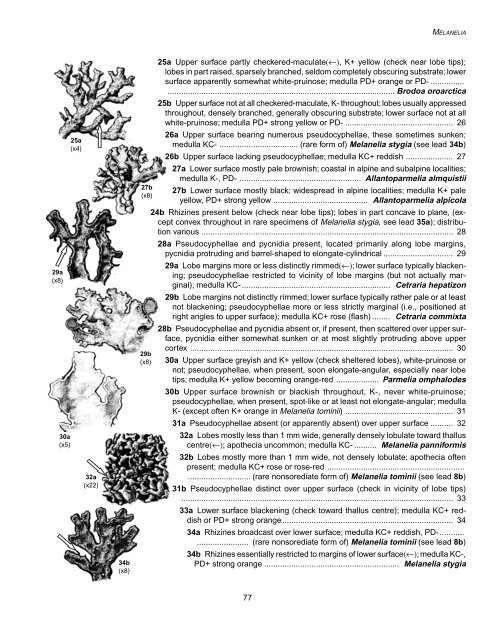74 MELANELIA Melanelia Essl. The Brown Lichens Small to ...
74 MELANELIA Melanelia Essl. The Brown Lichens Small to ...
74 MELANELIA Melanelia Essl. The Brown Lichens Small to ...
Create successful ePaper yourself
Turn your PDF publications into a flip-book with our unique Google optimized e-Paper software.
29a<br />
(x8)<br />
30a<br />
(x5)<br />
25a<br />
(x4)<br />
32a<br />
(x22)<br />
34b<br />
(x8)<br />
27b<br />
(x8)<br />
29b<br />
(x8)<br />
25a Upper surface partly checkered-maculate(←), K+ yellow (check near lobe tips);<br />
lobes in part raised, sparsely branched, seldom completely obscuring substrate; lower<br />
surface apparently somewhat white-pruinose; medulla PD+ orange or PD- ...............<br />
..................................................................................................... Brodoa oroarctica<br />
25b Upper surface not at all checkered-maculate, K- throughout; lobes usually appressed<br />
throughout, densely branched, generally obscuring substrate; lower surface not at all<br />
white-pruinose; medulla PD+ strong yellow or PD- ................................................ 26<br />
26a Upper surface bearing numerous pseudocyphellae, these sometimes sunken;<br />
medulla KC- ................................... (rare form of) <strong>Melanelia</strong> stygia (see lead 34b)<br />
26b Upper surface lacking pseudocyphellae; medulla KC+ reddish ..................... 27<br />
27a Lower surface mostly pale brownish; coastal in alpine and subalpine localities;<br />
medulla K-, PD- ...................................................... Allan<strong>to</strong>parmelia almquistii<br />
27b Lower surface mostly black; widespread in alpine localities; medulla K+ pale<br />
yellow, PD+ strong yellow .......................................... Allan<strong>to</strong>parmelia alpicola<br />
24b Rhizines present below (check near lobe tips); lobes in part concave <strong>to</strong> plane, (except<br />
convex throughout in rare specimens of <strong>Melanelia</strong> stygia, see lead 35a); distribution<br />
various ................................................................................................................ 28<br />
28a Pseudocyphellae and pycnidia present, located primarily along lobe margins,<br />
pycnidia protruding and barrel-shaped <strong>to</strong> elongate-cylindrical ............................... 29<br />
29a Lobe margins more or less distinctly rimmed(←); lower surface typically blackening;<br />
pseudocyphellae restricted <strong>to</strong> vicinity of lobe margins (but not actually marginal);<br />
medulla KC- .................................................................. Cetraria hepatizon<br />
29b Lobe margins not distinctly rimmed; lower surface typically rather pale or at least<br />
not blackening; pseudocyphellae more or less strictly marginal (i.e., positioned at<br />
right angles <strong>to</strong> upper surface); medulla KC+ rose (flash) ........ Cetraria commixta<br />
28b Pseudocyphellae and pycnidia absent or, if present, then scattered over upper surface,<br />
pycnidia either somewhat sunken or at most slightly protruding above upper<br />
cortex ..................................................................................................................... 30<br />
30a Upper surface greyish and K+ yellow (check sheltered lobes), white-pruinose or<br />
not; pseudocyphellae, when present, soon elongate-angular, especially near lobe<br />
tips; medulla K+ yellow becoming orange-red ................... Parmelia omphalodes<br />
30b Upper surface brownish or blackish throughout, K-, never white-pruinose;<br />
pseudocyphellae, when present, spot-like or at least not elongate-angular; medulla<br />
K- (except often K+ orange in <strong>Melanelia</strong> <strong>to</strong>minii) ................................................ 31<br />
31a Pseudocyphellae absent (or apparently absent) over upper surface .......... 32<br />
32a Lobes mostly less than 1 mm wide, generally densely lobulate <strong>to</strong>ward thallus<br />
centre(←); apothecia uncommon; medulla KC- .......... <strong>Melanelia</strong> panniformis<br />
32b Lobes mostly more than 1 mm wide, not densely lobulate; apothecia often<br />
present; medulla KC+ rose or rose-red .............................................................<br />
............................ (rare nonsorediate form of) <strong>Melanelia</strong> <strong>to</strong>minii (see lead 8b)<br />
31b Pseudocyphellae distinct over upper surface (check in vicinity of lobe tips)<br />
......................................................................................................................... 33<br />
33a Lower surface blackening (check <strong>to</strong>ward thallus centre); medulla KC+ reddish<br />
or PD+ strong orange............................................................................ 34<br />
34a Rhizines broadcast over lower surface; medulla KC+ reddish, PD-...........<br />
....................... (rare nonsorediate form of) <strong>Melanelia</strong> <strong>to</strong>minii (see lead 8b)<br />
34b Rhizines essentially restricted <strong>to</strong> margins of lower surface(←); medulla KC-,<br />
PD+ strong orange ............................................................ <strong>Melanelia</strong> stygia<br />
77<br />
<strong>MELANELIA</strong>

















